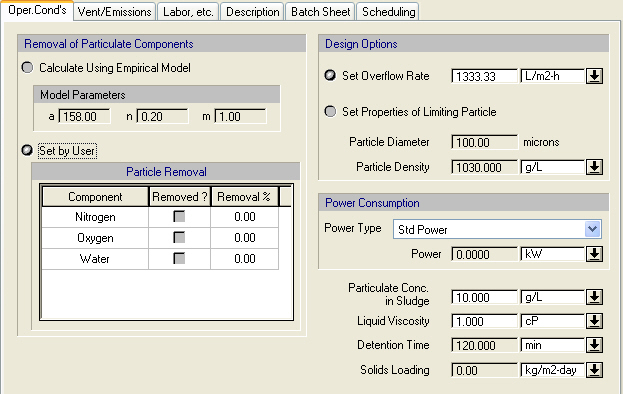

The following table shows a brief description of the variables appearing in this tab. The table also displays their default values and their generally acceptable range:
|
Variable |
Default Value |
Range |
|
|
||
|
○ a |
158.0 |
Positive |
|
○ n |
0.2 |
Positive |
|
○ m |
1.0 |
Positive |
|
○ Removed ? |
<No> |
Yes/No |
|
◙ Removal % |
0.0 |
0 – 100 |
|
○ Overflow rate (m3/m2-day) |
32.0 |
Positive |
|
○ Particle Diameter (microns) |
100 |
Positive |
|
○ Particle Density (kg/m3) |
1,030 |
Positive |
|
○ Power Type |
<Std Power> |
Any Power Type |
|
● Power (kW) |
0.0 |
Positive |
|
○ Particle Concentration in Sludge (g/L) |
10.0 |
Positive |
|
○ Liquid Viscosity (cP) |
1.0 |
Positive |
|
● Detention Time (h) |
2.0 |
Positive |
|
● Solids Loading (kg/m2-day) |
0.0 |
Positive |
Symbol Key: ○ User-specified value (always input); ● Calculated value (always output); ◙ Sometimes input, sometimes output
The following list describes the available specification choices in this tab; for more details on how these are implemented, see Clarification: Modeling Calculations.
•Empirical Model Parameters...
The parameters {a, n, and m} are required when the removal percentage of particulate components is calculated by the built-in empirical model.
•Design Options...
In Design Mode of calculation, the sizing (calculation of the surface area) of the tank is based either on the overflow rate or the sedimentation velocity of a limiting particle whose properties (density and diameter) must be specified.